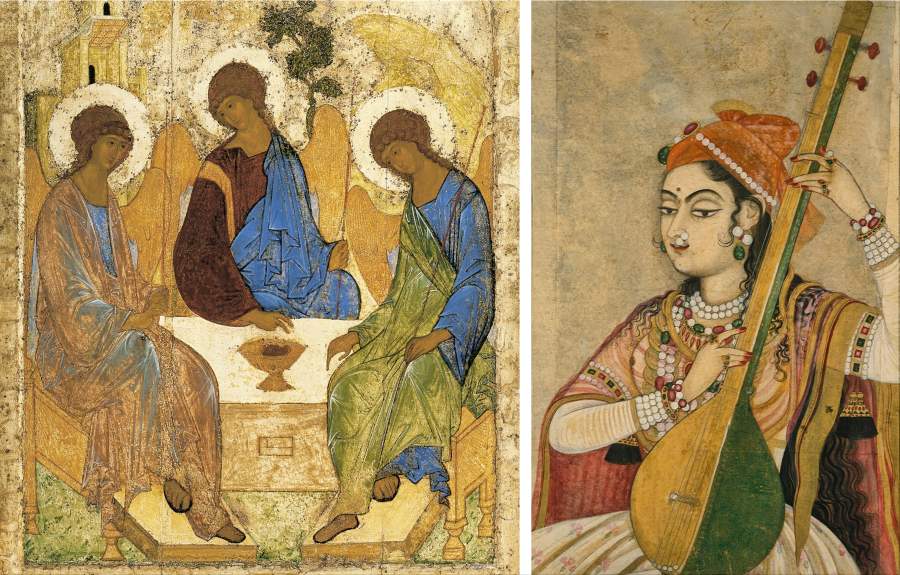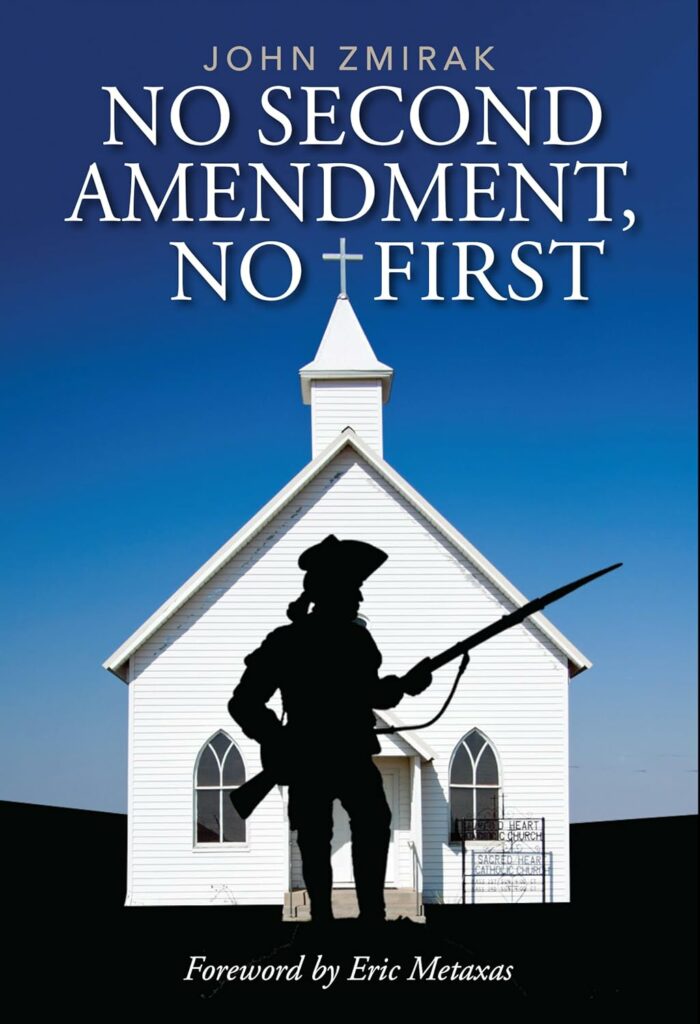Three Notes in One Chord, Three Persons in One God

“Oh, East is east and west is west and never the twain shall meet.” Thus wrote Rudyard Kipling, novelist, poet and short-story writer in his poem The Ballad of East and West. Kipling was born in India and is best known for his children’s tale The Jungle Book.
We can only guess what Kipling might have said had he been served a dish where east and west have indeed met. I’m thinking of Britain’s national dish — chicken tikka masala. And yet, in so many aspects one would have to concede that Kipling was right. Take music, for instance.
Three Notes in One Chord
For hundreds of years, the essence of western music has been polyphonic. The first, third and fifth notes of a scale when sounded together form a major chord. The first, flat third and fifth notes of a scale when sounded together form a minor chord. Each note is of the same substance (musical sound). Yet each note is different (different pitch).
Three notes in one chord? To Indian musicians this is a contradiction that cannot be resolved.
This is because Indian classical music is strictly monophonic. A note is a note is a note. It exists in splendid isolation as a note. It cannot live in harmony with other notes. Indian classical music can conceive only of soloists and never an orchestra. Soloists are accompanied just by a drone instrument and a percussion instrument.
On the other hand, Western musicians simply cannot comprehend the microtones and intricate rhythms used by Indian musicians. To them an Indian musician is like a pianist who ignores the white keys and the black keys on the piano and tries to play in the cracks between the keys.
While the logic of Eastern music cannot work out how three notes can make one chord, the logic of Western metaphysics struggles to understand how three persons can make one God.
The Oriental Faith of the Bible
The biblical faith is Eastern rather than Western. An Eastern framework uses a “both–and” approach. A Western framework tends to use an “either–or” approach. Jesus is both fully God and fully human. God is both one and three. The Trinity is the epitome of the “both–and” formulation.
But does the Hebrew Bible not tell us that God is one? The Jewish creed, the Shema, affirms the oneness of God. “Hear, O Israel: The LORD our God, the LORD is one” (Deuteronomy 6:4).
When Jesus is asked to name the greatest commandment, he quotes the Shema: “The first is, ‘Hear, O Israel: the Lord our God, the Lord is one’” (Mark 12:29). James the brother of Jesus writes: “You believe that God is one; you do well. Even the demons believe — and shudder” (James 2:19).
So, is the God of Israel rigidly monotheistic? There are hints that the Hebrew Bible does leave room for believing in a plurality within the Godhead. The most common word used for God in the Old Testament is the plural Elohim.
God the Trinity Creating Humanity
While creating human beings God holds conversation with what appears to be equal partners: “Then God said, ‘Let us make humankind in our image, according to our likeness…’” (Genesis 1:26). This could be God using the plural of majesty—like the Queen does. This could be God talking to his angelic council.
But is there something more here? Is this the Holy Trinity in trialogue? Is this not why the Trinity creates humanity as a plurality — as man and woman — so that we are able to reflect the image and likeness of a Trinitarian God of love?
Just as “God is one” is bottom line Old Testament teaching, so it is also bottom line New Testament teaching. But the New Testament pushes this further to include Jesus and the Holy Spirit as God.
Three notes, distinct and yet of the same nature or substance, in perfect harmony in one chord. Three persons, distinct and yet of the same nature or substance, in perfect harmony in one God.
Rublev Unveils the Relational Theology of the Trinity
The Trinity is not only a puzzle for Western metaphysics, but in a hyper-individualistic society the Trinity poses a problem that is not merely rational but also relational.
Turning from music to painting — from the Indian raga to the Russian Rublev — might help us to come to terms with the relational theology of the Holy Trinity.
Andrei Rublev’s icon of the Trinity is surely the most famous icon in the world. It is inspired by the story in Genesis 18 of three visitors who come to see Abraham. Three angels unite in a serene circle around the chalice at the center of the table, towards which the hands of all three gesture.
There is a fourth place at the front of the table. The fourth place is reserved for the viewer; for you and me. Rublev is inviting you and me to encounter the Trinity and to sit down with this community of perfect love. He is inviting us to make the Trinity a Quartet.
Rublev is telling us that the Trinity is one way of making real the Christian claim that God is love. Because God is love, God could not exist in splendid isolation even in eternity. For love to be love, there must be another person or persons to love.
For a note to be in harmony, there must be another note or notes to harmonize with. Because God is love, God has always existed in plurality like a chord in perfect harmony and not like a note in splendid isolation.
Trinitarian Theology is Unique
Perhaps that is why no other religion teaches as its central claim “God is Love,” because no other religion conceives of God as dwelling in a Trinity of perfect harmony and perfect love.
Mahatma Gandhi, deeply influenced by the Sermon on the Mount, would repeatedly affirm that “God is Truth” but could never bring himself to utter the three most sublime words from the letter of St. John “God is Love.” This is because Gandhi remained a devout Hindu, and monistic Hinduism conceives of God as an impersonal principle.
Islam, although a monotheistic religion, finds the idea of a Trinity utterly blasphemous to the oneness of God. “Lo! Whoso ascribeth partners unto Allah, for him Allah hath forbidden Paradise. His abode is the Fire,” the Koran warns. (Sura V 72-73, cf. Sura IV 171).
Rublev is also trying to tell us that since we are created in the image and likeness of God, the Trinity is not some abstract doctrine, remote from our everyday life. Rublev’s icon has a small tree at the back to represent the Oaks of Mamre where Abraham has ordinary and extraordinary experiences with both God and man.
Participating in the Life of the Trinity
Rublev’s figures of the Holy Trinity are both human and divine. Rublev is trying to tell us that “if we are made in the image of God, we are made in the image of the Trinity; and the life of the Trinity must in some sorts be reflected in the pattern of our human life,” writes the Jesuit Fr. John F. X. Harriott.
We are invited to participate in this Trinitarian love through baptism — administered in the name of the Father and of the Son and of the Holy Spirit.
Please Support The Stream: Equipping Christians to Think Clearly About the Political, Economic, and Moral Issues of Our Day.
We are invited to grow in this Trinitarian love through Trinitarian prayer — for all Christian prayer is prayer to the Father, in the name of Jesus, through the Holy Spirit.
We are invited to share this good news in obedience to Jesus’s great commission: “Go therefore and make disciples of all the nations, baptizing them in the name of the Father and the Son and the Holy Spirit” (Matthew 28:19).
Paradoxically, East and West do meet in Kipling’s poem. He writes:
Oh, East is East, and West is West, and never the twain shall meet,
Till Earth and Sky stand presently at God’s great Judgment Seat;
But there is neither East nor West, Border, nor Breed, nor Birth,
When two strong men stand face to face, tho’ they come from the ends of the earth!
The hymn-writer John Oxenham echoes these words:
In Christ there is no east or west,
In him no south or north,
but one great fellowship of love
Throughout the whole wide earth.
Dr. Jules Gomes, (BA, BD, MTh, PhD), has a doctorate in biblical studies from the University of Cambridge. Currently a Vatican-accredited journalist based in Rome, he is the author of five books and several academic articles. Gomes lectured at Catholic and Protestant seminaries and universities and was canon theologian and artistic director at Liverpool Cathedral.


